Volcanic Rocks from Western Limnos Island, Greece: Petrography, Magnetite Geochemistry, and Magnetic Susceptibility Constraints
Abstract
1. Introduction
2. Geological Setting
3. Materials and Methods
4. Results
4.1. Petrography
4.2. Lithogeochemistry
4.3. Magnetite, Ilmenite, and Titanite Mode of Occurrence
4.4. Magnetic Susceptibility
5. Discussion
5.1. Petrogenesis of High-K to Shoshonitic Magmatism
5.2. Fe–Ti Oxides and Magnetic Susceptibility as Petrogenetic Tracers
6. Conclusions
Supplementary Materials
Author Contributions
Funding
Data Availability Statement
Acknowledgments
Conflicts of Interest
References
- Miyashiro, A. Volcanic rock series in island arcs and active continental margins. Am. J. Sci. 1974, 274, 321–355. [Google Scholar] [CrossRef]
- McCulloch, M.T.; Gamble, J.A. Geochemical and geodynamical constraints on subduction zone magmatism. Earth Planet. Sci. Lett. 1991, 102, 358–374. [Google Scholar] [CrossRef]
- Hawkesworth, C.J.; Gallagher, K.; Hergt, J.M.; McDermott, F. Mantle and slab contributions in arc magmas. Ann. Rev. Earth Planet. Sci. 1993, 21, 175–204. [Google Scholar] [CrossRef]
- Schmidt, M.W.; Jagoutz, O. The global systematics of primitive arc melts. Geochem. Geophys. Geosyst 2017, 18, 2817–2854. [Google Scholar] [CrossRef]
- Davidson, J.P.; Hora, J.M.; Garrson, J.; Dungan, M.A. Crustal forensics in arc magmas. J. Volcanol. Geoth Res. 2005, 140, 157–170. [Google Scholar] [CrossRef]
- Sun, C.H.; Stern, R.J. Genesis of Mariana shoshonites: Contribution of the subduction component. J. Geophys. Res. 2001, 106, 589–608. [Google Scholar] [CrossRef]
- Marschall, H.R.; Schumacher, J.C. Arc magmas sourced from mélange diapirs in subduction zones. Nat. Geosci. 2012, 5, 862–867. [Google Scholar] [CrossRef]
- Straub, S.M.; LaGatta, A.B.; Martin-Del Pozzo, A.L.; Langmuir, C.H. Evidence from high-Ni olivines for a hybridized peridotite/pyroxenite source for orogenic andesites from the central Mexican Volcanic Belt. Geochem. Geophys. Geosyst 2008, 9, Q03007. [Google Scholar] [CrossRef]
- Perrin, A.; Goes, S.; Prytulak, J.; Rondenay, S.; Davies, D.R. Mantle wedge temperatures and their potential relation to volcanic arc location. Earth Planet. Sci. Lett. 2018, 501, 67–77. [Google Scholar] [CrossRef]
- Schaarschmidt, A.; Haase, K.M.; Voudouris, P.C.; Melfos, V.; Klemd, R. Migration of arc magmatism above mantle wedge diapirs with variable sediment contribution in the Aegean. Geochem. Geophys. Geosyst. 2021, 22, e2020GC009565. [Google Scholar] [CrossRef]
- Schaarschmidt, A.; Klemd, R.; Regelous, M.; Voudouris, P.; Melfos, V.; Haase, K.M. The formation of shoshonitic magma and its relationship to porphyry-type mineralisation: The Maronia pluton in NE Greece. Lithos 2012, 380–381, 105911. [Google Scholar] [CrossRef]
- Schmid, S.M.; Fügenschuh, B.; Kounov, A.; Matenco, L.; Nievergelt, P.; Oberhänsli, R.; Pleuger, J.; Schefer, S.; Schuster, R.; Tomljenovic, B.; et al. Tectonic units of the Alpine collision zone between Eastern Alps and western Turkey. Gondwana Res. 2020, 78, 308–374. [Google Scholar] [CrossRef]
- Kilias, A. The Alpine Geological History of the Hellenides from the Triassic to the Present—Compression vs. Extension, a Dynamic Pair for Orogen Structural Configuration: A Synthesis. Geosciences 2023, 14, 10. [Google Scholar] [CrossRef]
- Jolivet, L.; Menant, A.; Sternai, P.; Rabillard, A.; Arbaret, L.; Augier, R.; Laurent, V.; Beaudoin, A.; Grasemann, B.; Huet, B.; et al. The geological signature of a slab tear below the Aegean. Tectonophysics 2015, 659, 166–182. [Google Scholar] [CrossRef]
- Brun, J.P.; Sokoutis, D. 45 my of Aegean crust and mantle flow driven by trench retreat. Geology 2010, 38, 815–818. [Google Scholar] [CrossRef]
- Brun, J.P.; Sokoutis, D. Core complex segmentation in North Aegean, a dynamic view. Tectonics 2018, 37, 1797–1830. [Google Scholar] [CrossRef]
- Rohrmeier, M.K.; von Quadt, A.; Driesner, T.; Heinrich, C.A.; Handler, R.; Ovtcharova, M.; Ivanov, Z.; Petrov, P.; Sarov, S.; Peytcheva, I. Post-orogenic extension and hydrothermal ore formation: High-precision geochronology of the central Rhodopian metamorphic core complex (Bulgaria-Greece). Econ. Geol. 2013, 108, 691–718. [Google Scholar] [CrossRef]
- van Hinsbergen, D.J.J.; Schmid, S.M. Map view restoration of Aegean-West Anatolian accretion and extension since the Eocene. Tectonics 2012, 31, TC5005. [Google Scholar] [CrossRef]
- Pe-Piper, G.; Piper, D.J.W. The Igneous Rocks of Greece: The Anatomy of an Orogen, 1st ed.; Gebrüder Borntraeger: Berlin, Germany, 2002; p. 645. [Google Scholar]
- Pe-Piper, G.; Piper, D.; Kokouvelas, I.; Dolansky, L.; Kokkalas, S. Postorogenic shoshonitic rocks and their origin by melting underplated basalts: The Miocene of Limnos, Greece. Geol. Soc. Am. Bull. 2009, 121, 39–54. [Google Scholar] [CrossRef]
- Pe-Piper, G.; Zhang, Y.; Piper, D.J.; Prelevic, D. Relationship of Mediterranean type lamproites to large shoshonite volcanoes, Miocene of Lesbos, NE Aegean Sea. Lithos 2014, 184–187, 281–299. [Google Scholar] [CrossRef]
- Christofides, G.; Pinarelli, L.; Pipera, K.; Soldatos, T.; Koroneos, A. Geochemical features of the depression basin-related magmatism in southeastern Rhodope massif and Circum-Rhodope Belt: The Tertiary Evros volcanic rocks (Western Thrace, northeastern Greece). Acta Vulcanol. J. Natl. Volcan. Group. Italy 2013, 25, 43–56. [Google Scholar]
- Erenoglu, O.; Bozcu, M.; Billor, M.Z. Age and petrology of Eocene-Oligocene calc-alkaline volcanism in Biga Peninsula (NW Turkey): Implications for magma origin and geodynamic evolution. J. Afr. Earth Sci. 2022, 192, 104559. [Google Scholar] [CrossRef]
- Gläser, L.; Grosche, A.; Voudouris, P.C.; Haase, K.M. The high-K calc-alkaline to shoshonitic volcanism of Limnos, Greece: Implications for the geodynamic evolution of the northern Aegean. Contrib. Mineral. Petrol. 2022, 177, 73. [Google Scholar] [CrossRef]
- Rabayrol, F.; Hart, C.J. Petrogenetic and tectonic controls on magma fertility and the formation of post-subduction porphyry and epithermal mineralization along the late Cenozoic Anatolian Metallogenic Trend, Turkey. Miner. Depos. 2021, 56, 279–306. [Google Scholar] [CrossRef]
- Börner, F.; Keith, M.; Bücker, J.L.; Voudouris, P.; Klemd, R.; Haase, K.; Kutzschbach, M.; Schiperski, F. In-situ trace element and S isotope systematics in pyrite from three porphyry-epithermal prospects, Limnos Island, Greece. Front. Earth Sci. 2022, 10, 916107. [Google Scholar] [CrossRef]
- Sanchez, M.G.; McClay, K.; King, A. Crustal extension and its relationship to porphyry Cu-Au and epithermal Au mineralization in the Biga Peninsula, NW Turkey. Soc. Econ. Geol. Spec. Publ. 2016, 19, 113–156. [Google Scholar]
- Melfos, V.; Voudouris, P. Cenozoic metallogeny of Greece and potential for precious, critical and rare metals exploration. Ore Geol. Rev. 2017, 89, 1030–1057. [Google Scholar] [CrossRef]
- Voudouris, P.; Mavrogonatos, C.; Spry, P.G.; Baker, T.; Melfos, V.; Klemd, R.; Haase, K.; Repstock, A.; Djiba, A.; Bismayer, U.; et al. Porphyry and epithermal deposits in Greece: An overview, new discoveries, and mineralogical constraints on their genesis. Ore Geol. Rev. 2019, 107, 654–691. [Google Scholar] [CrossRef]
- Stergiou, C.L.; Sakellaris, G.-A.; Melfos, V.; Voudouris, P.; Papadopoulou, L.; Kantiranis, N.; Peytcheva, I.; Chatzipetros, A.; Dimitrova, D.; Stefanova, E. Metallogeny and distribution of critical and strategic metals in the polymetallic vein mineralization at Kolchiko, Vertiskos Unit, northern Greece. J. Geoch. Expl. 2025, 272, 107708. [Google Scholar] [CrossRef]
- Vlahou, M.; Christofides, G.; Eleftheriadis, G.; Pinarelli, L.; Koroneos, A. Tertiary volcanic rocks from Samothraki island (north Aegean, Greece): Sr and Nd isotope constraints on their evolution. Geol. Soc. Am. Spec. Pap. 2006, 409, 283–304. [Google Scholar]
- Chatzipetros, A.; Kiratzi, A.; Sboras, S.; Zouros, N.; Pavlides, S. Active faulting in the north-eastern Aegean Sea Islands. Tectonophysics 2013, 597, 106–122. [Google Scholar] [CrossRef]
- Kondopoulou, D.; Atzemoglou, A.; Pavlides, S. Palaeomagnetism as a tool for testing geodynamic models in the North Aegean: Convergences, controversies and a further hypothesis. Geol. Soc. Spec. Publ. 1996, 105, 277–288. [Google Scholar] [CrossRef]
- Kondopoulou, D. Palaeomagnetism in Greece: Cenozoic and Mesozoic components and their geodynamic implications. Tectonophysics 2000, 326, 131–151. [Google Scholar] [CrossRef]
- Sakellariou, D.; Tsampouraki-Kraounaki, K. Plio-Quaternary extension and strike-slip tectonics in the Aegean. In Transform Plate Boundaries and Fracture Zones, 1st ed.; Duarte, J.C., Ed.; Elsevier: Amsterdam, Holland, 2019; pp. 339–374. [Google Scholar]
- Tranos, M.D. Faulting of Limnos Island; A mirror of faulting of the North Aegean Trough (Northern Greece). Tectonophysics 2009, 467, 72–88. [Google Scholar] [CrossRef]
- Westphal, M.; Kondopoulou, D. Paleomagnetism of Miocene volcanics from Lemnos island: Implications for block rotations in the vicinity of the north Aegean Trough. Ann. Τectonicae 1993, 7, 142–149. [Google Scholar]
- Koukousioura, O.; Kouli, K.; Gkouma, M.; Theocharidis, N.; Ntinou, M.; Chalkioti, A.; Dimou, V.G.; Fatourou, E.; Navrozidou, V.; Kafetzidou, A.; et al. Reconstructing the Environmental Conditions in the Prehistoric Coastal Landscape of SE Lemnos Island (Greece) Since the Late Glacial. Water 2025, 17, 220. [Google Scholar] [CrossRef]
- Pavlides, S.; Tsapanos, T.; Zouros, N.; Sboras, S.; Koravos, G.; Chatzipetros, A. Using active fault data for assessing seismic hazard: A case study from NE Aegean Sea, Greece. In Proceedings of the Earthquake Geotechnical Engineering Satellite Conference XVIIth International Conference on Soil Mechanics & Geotechnical Engineering, Alexandria, Egypt, 5–9 October 2009. [Google Scholar]
- Roussos, N. Geological Map of Greece: Myrina-Moudros Map Sheet, 1:50,000; IGME: Acharnes, Athens, 1987. [Google Scholar]
- Maravelis, A.G.; Boutelier, D.; Catuneanu, O.; Seymour, K.S.; Zelilidis, A. A review of tectonics and sedimentation in a forearc setting: Hellenic Thrace Basin, North Aegean Sea and Northern Greece. Tectonophysics 2016, 674, 1–19. [Google Scholar] [CrossRef]
- Marchev, P.; Raicheva, R.; Ivanova, R.; Peytcheva, I.; Grozdev, V. Early Oligocene Supereruption in SE Europe Outlined by 33.3 Ma U-Pb Ages for Limnos Tuff and Correlation with Regional Ash Deposits. C. R. Acad. Bulg. Sci. 2021, 74, 396–405. [Google Scholar]
- Innocenti, F.; Manetti, P.; Mazzuoli, R.; Pertusati, P.; Fytikas, M.; Kolios, N.; Vougioukalakis, G.E.; Androulakakis, N.; Critelli, S.; Caracciolo, L. Geological map (scale 1:50,000) of Limnos island (Greece): Explanatory notes. Acta Vulcanol. 2009, 21, 123–134. [Google Scholar]
- Innocenti, F.; Manetti, P.; Mazzuoli, R.; Pertusati, P.; Fytikas, M.; Kolios, N. The geology and geodynamic significance of the Island of Limnos, North Aegean Sea, Greece. Neues Jb Geol. 1994, 11, 661–691. [Google Scholar] [CrossRef]
- Fytikas, M.; Giuliani, O.; Innocenti, F.; Manetti, P.; Mazzuoli, R.; Peccerillo, A.; Villari, L. Neogene volcanism of the northern and central Aegean region. Ann. Geol. Pays Hell. 1980, 30, 106–129. [Google Scholar]
- Fytikas, M.; Innocenti, F.; Manetti, P.; Mazzuoli, R.; Peccerillo, A.; Villari, L. Teriary to Quaternary evolution of volcanism in the Aegean region. In Geological Evolution of the Eastern Mediterranean, 1st ed.; Dixon, J.E., Robertson, A.H.F., Eds.; Geological Society of London Special Publication: London, UK, 1984; Volume 17, pp. 687–699. [Google Scholar]
- Fornadel, A.P.; Voudouris, P.C.; Spry, P.G.; Melfos, V. Mineralogical, stable isotope, and fluid inclusion studies of spatially related porphyry Cu and epithermal Au-Te mineralization, Fakos Peninsula, Limnos Island, Greece. Miner. Petrol. 2012, 105, 85–111. [Google Scholar] [CrossRef]
- Erbil, Ü.; Okay, A.I.; Hakyemez, A. Late oligocene-early Miocene shortening in the Thrace Basin, northern Aegean. Int. J. Earth Sci. 2021, 110, 1921–1936. [Google Scholar] [CrossRef]
- Ring, U.; Layer, P.W.; Reischmann, T. Miocene high-pressure metamorphism in the Cyclades and Crete, Aegean Sea, Greece: Evidence for large-magnitude displacement on the Cretan detachment. Geology 2001, 29, 395–398. [Google Scholar] [CrossRef]
- Schneider, C.A.; Rasband, W.S.; Eliceiri, K.W. NIH Image to ImageJ: 25 years of image analysis. Nat. Methods 2012, 9, 671–675. [Google Scholar] [CrossRef]
- Pe-Piper, G.; Piper, D.J. Geochemical variation with time in the Cenozoic high-K volcanic rocks of the island of Lesbos, Greece: Significance for shoshonite petrogenesis. J. Volcanol. Geotherm. Res. 1992, 53, 371–387. [Google Scholar] [CrossRef]
- Gündüz, M.; Asan, K. PetroGram: An excel-based petrology program for modeling of magmatic processes. Geosci. Front. 2013, 12, 81–92. [Google Scholar] [CrossRef]
- Dearing, J.A.; Dann, R.J.L.; Hay, K.; Lees, J.A.; Loveland, P.J.; Maher, B.A.; O’grady, K. Frequency-dependent susceptibility measurements of environmental materials. Geophys. J. Int. 1996, 124, 228–240. [Google Scholar] [CrossRef]
- Tarling, D.; Hrouda, F. Magnetic Anisotropy of Rocks, 1st ed.; Champan and Hall: London, UK, 1993; p. 218. [Google Scholar]
- Hrouda, F. Magnetic anisotropy of rocks and its application in geology and geophysics. Geophys. Surv. 1982, 5, 37–82. [Google Scholar] [CrossRef]
- Le Bas, M.J.; Le Maitre, R.W.; Streckeisen, A.; Zanettin, B. A chemical classification of volcanic rocks based on the total alkali-silica diagram. J. Petrol. 1986, 27, 745–750. [Google Scholar] [CrossRef]
- Winchester, J.A.; Floyd, P.A. Geochemical discrimination of different magma series and their differentiation products using immobile elements. Chem. Geol. 1977, 20, 325–343. [Google Scholar] [CrossRef]
- Peccerillo, A.; Taylor, S.R. Geochemistry of Eocene calc-alkaline volcanic rocks from the Kastamonu area, northern Turkey. Contrib. Mineral. Petrol. 1976, 58, 63–81. [Google Scholar] [CrossRef]
- Pearce, J.A. A users guide to basalt discrimination diagrams. In Trace Element Geochemistry of Volcanic Rocks: Applications for Massive Sulphide Exploration; Wyman, D.A., Ed.; Geological Association of Canada: St. John’s, NL, Canada, 1996; Short Course Notes 12; pp. 79–113. [Google Scholar]
- Frost, B.R.; Frost, C.D. A geochemical classification for feldspathic igneous rocks. J. Petrol. 2008, 49, 1955–1969. [Google Scholar] [CrossRef]
- Pearce, J.A. Trace element characteristics of lavas from destructive plate boundaries. In Andesites: Orogenic Andesites and Related Rocks, 1st ed.; Thorp, R.S., Ed.; John Wiley and Sons: New York, NY, USA, 1982; pp. 525–548. [Google Scholar]
- Hollocher, K.; Robinson, P.; Walsh, E.; Roberts, D. Geochemistry of amphibolite-facies volcanics and gabbros of the Støren Nappe in extensions west and southwest of Trondheim, Western Gneiss Region, Norway: A key to correlations and paleotectonic settings. Am. J. Sci. 2012, 312, 357–416. [Google Scholar] [CrossRef]
- Hughes, C.J. Spilites, keratophyres, and the igneous spectrum. Geol. Mag. 1972, 109, 513–527. [Google Scholar] [CrossRef]
- Sun, S.S.; McDonough, W.F. Chemical and isotopic systematics of oceanic basalts: Implications for mantle composition and processes. Geol. Soc. Lond. Spec. Publ. 1989, 42, 313–345. [Google Scholar] [CrossRef]
- Gualda, G.A.; Ghiorso, M.S.; Lemons, R.V.; Carley, T.L. Rhyolite-MELTS: A modified calibration of MELTS optimized for silica-rich, fluid-bearing magmatic systems. J. Petrol. 2012, 53, 875–890. [Google Scholar] [CrossRef]
- Marsh, B.D. On the interpretation of crystal size distributions in magmatic systems. J. Petrol. 1998, 39, 553–599. [Google Scholar] [CrossRef]
- Buddington, A.F.; Linsley, D.H. Iron-titanium oxides minerals and synthetic equivalents. J. Petrol. 1964, 5, 310–357. [Google Scholar] [CrossRef]
- Carmichael, R.S. Practical Handbook of Physical Properties of Rocks and Minerals, 1st ed.; CRC Press Inc.: Boca Raton, FL, USA, 1989; p. 756. [Google Scholar]
- Borradaile, G.J. Magnetic susceptibility, petrofabrics and strain. Tectonophysics 1988, 156, 1–20. [Google Scholar] [CrossRef]
- Ishihara, S.; Hashimoto, M.; Machida, M. Magnetite/ilmenite–series classification and magnetic susceptibility of the Mesozoic-Cenozoic batholiths in Peru. Resour. Geol. 2000, 50, 123–129. [Google Scholar] [CrossRef]
- Flanders, P.J.; Remeika, J.P. Magnetic properties of hematite single crystals. Philos. Mag. A J. Theor. Exp. Appl. Phys. 1965, 11, 1271–1288. [Google Scholar] [CrossRef]
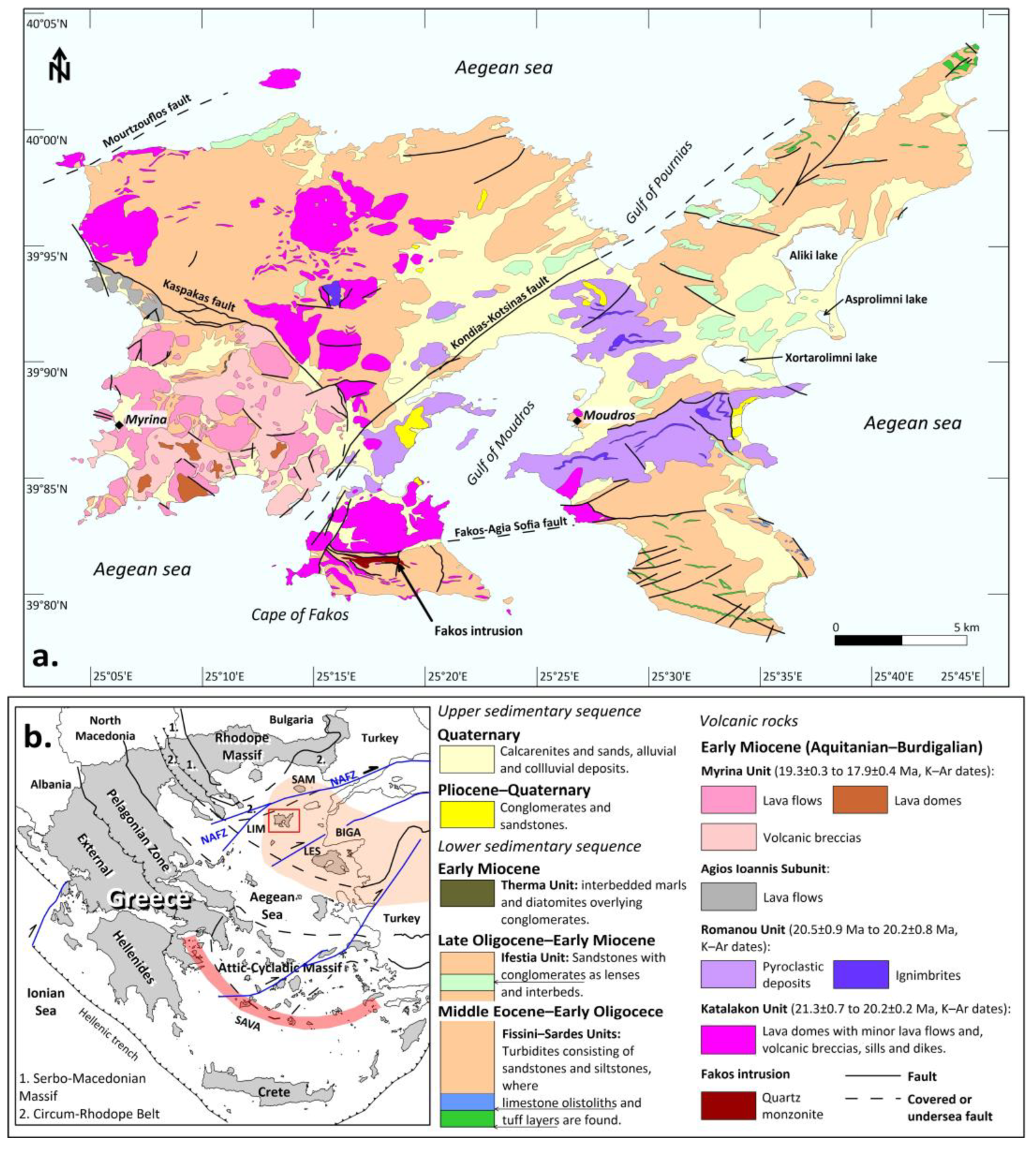



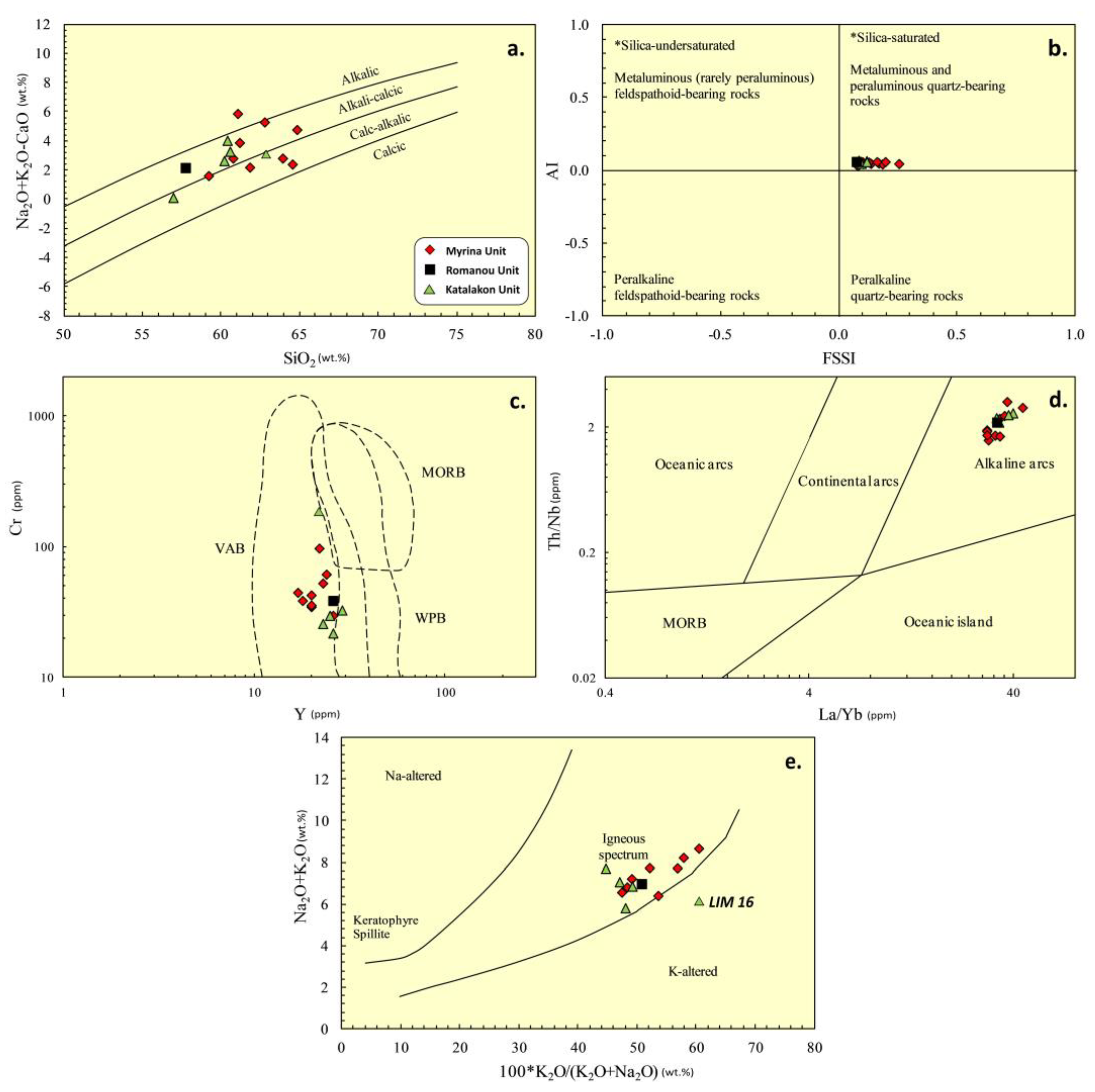
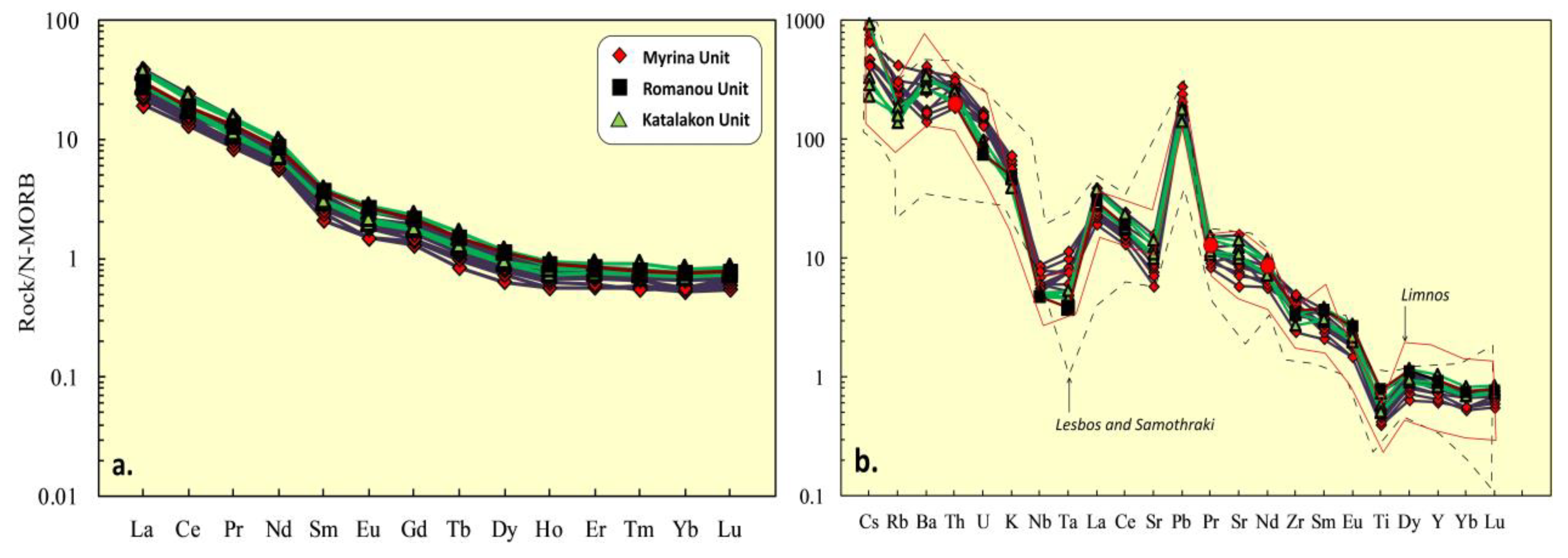
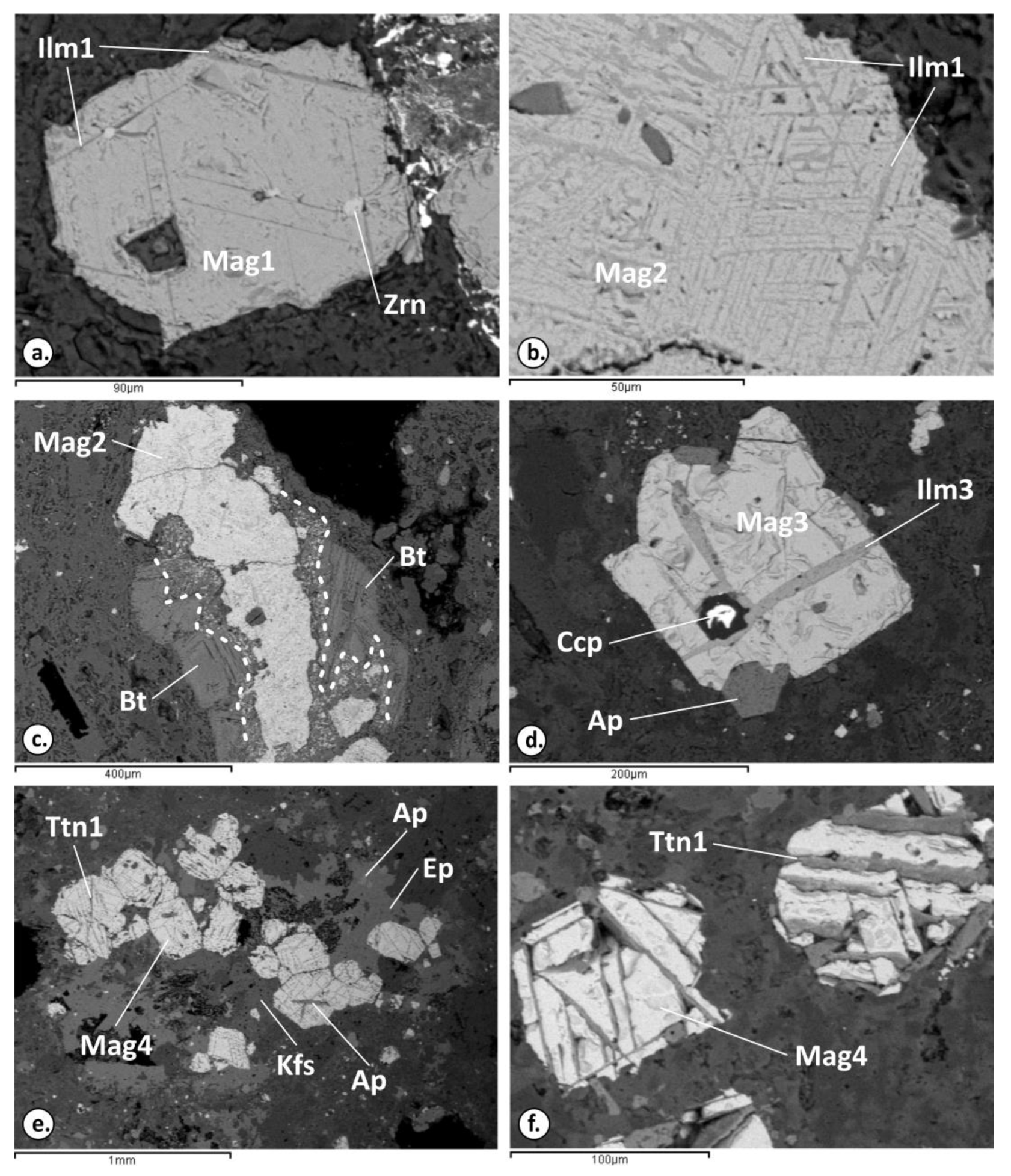
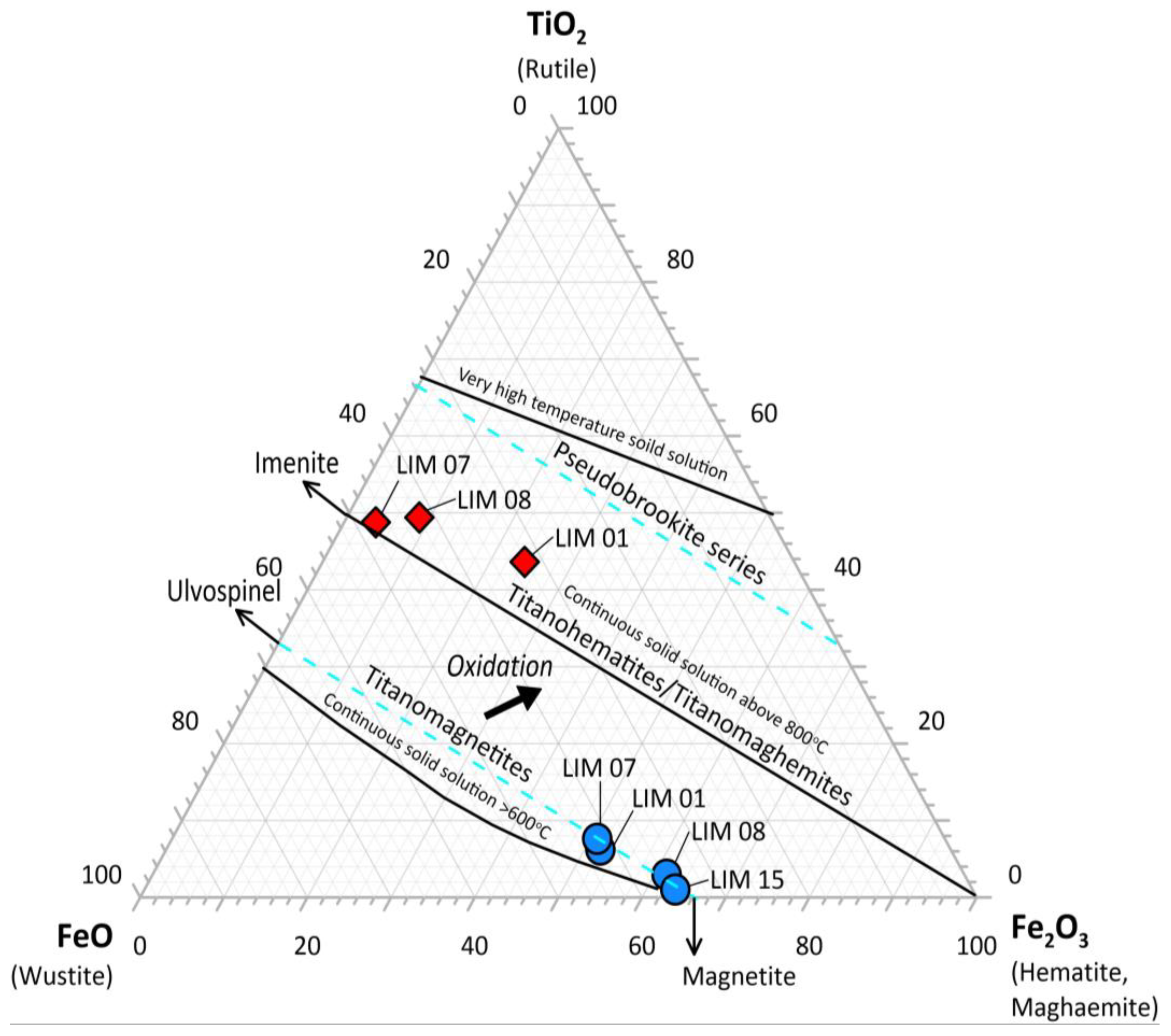
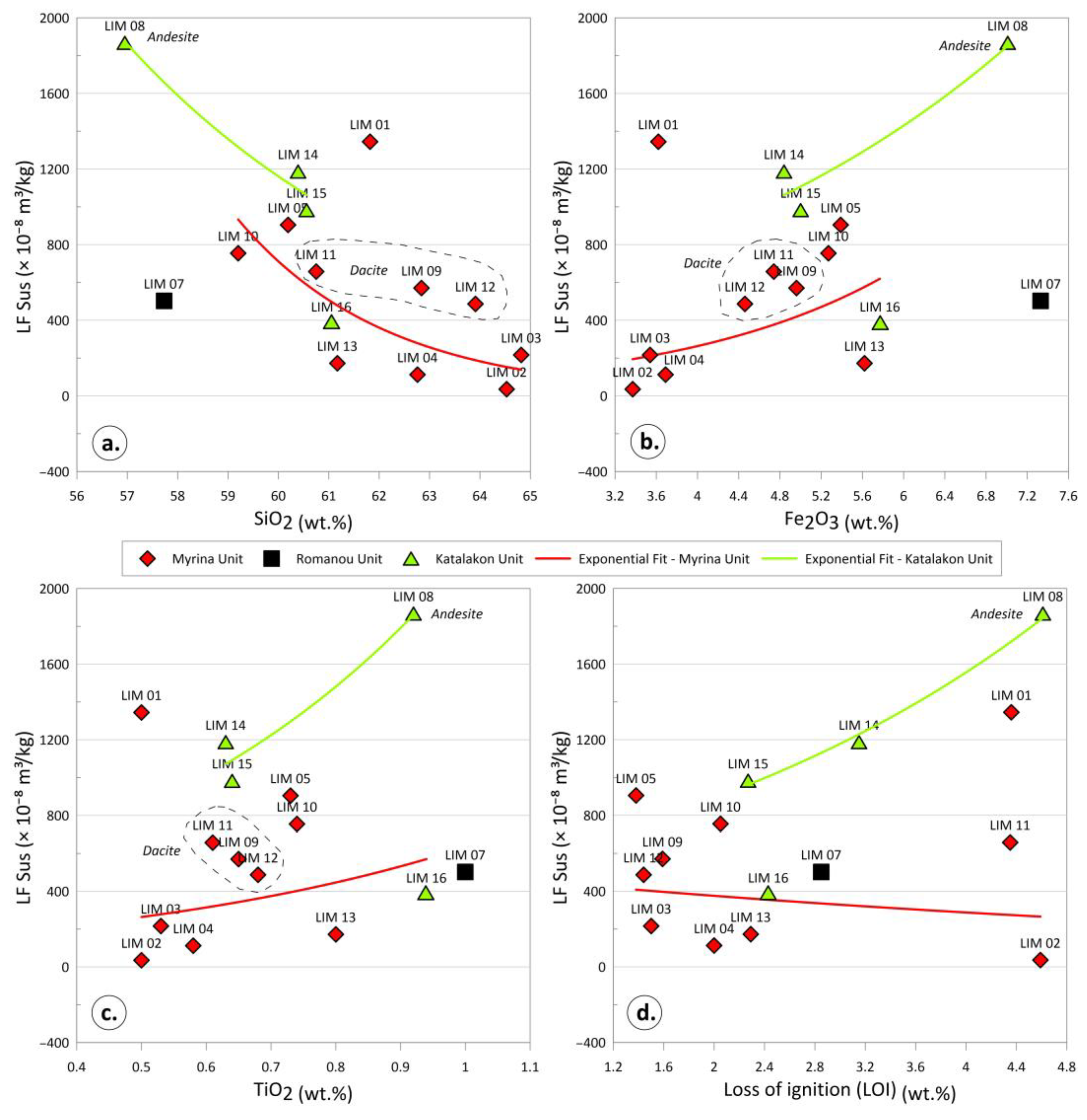
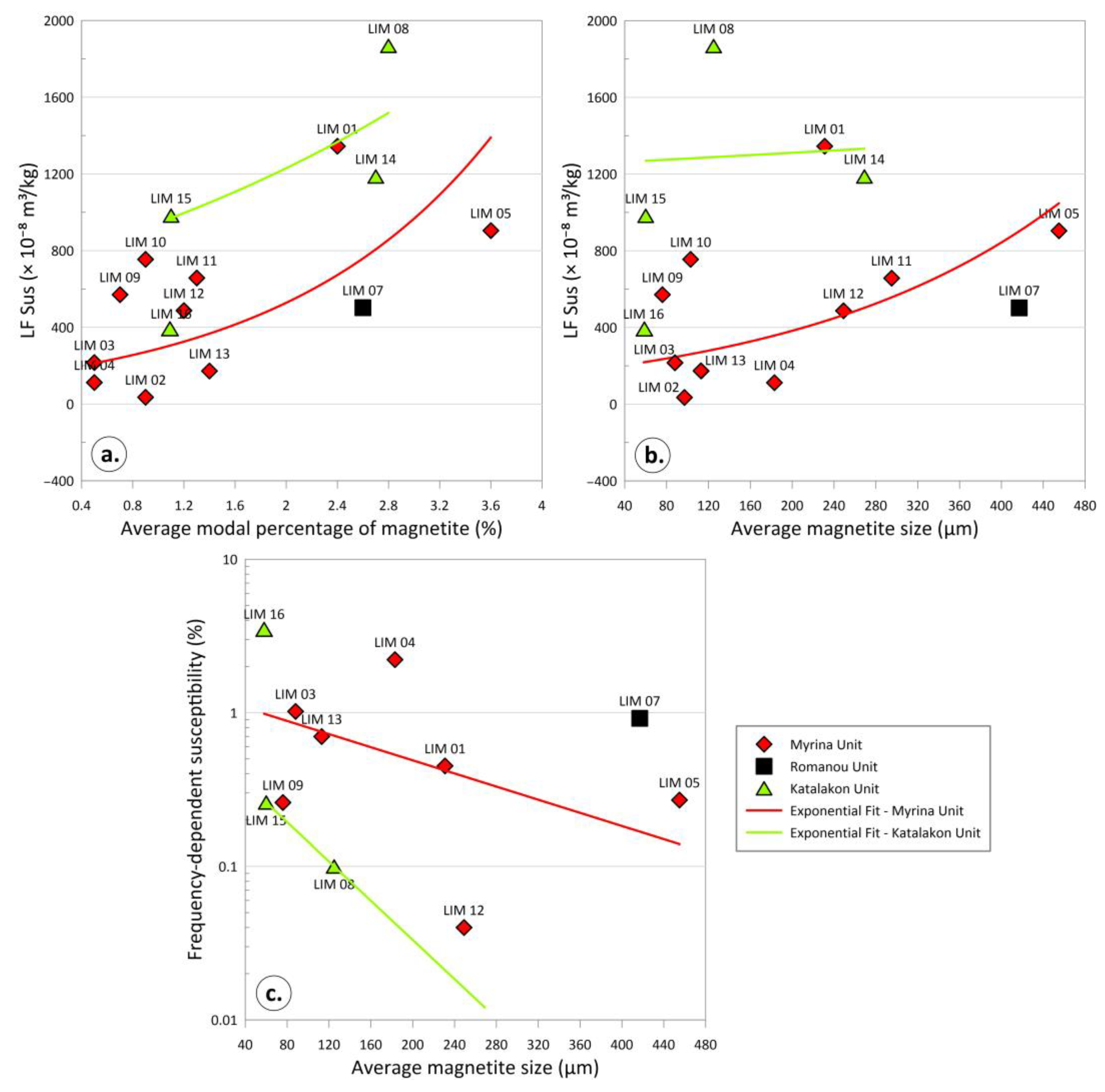
| Sample ID | Coordinates (Latitude/Longitude) | Lithological Description |
|---|---|---|
| LIM 01 | 39.886600° 25.069800° | Trachydacite; Myrina Unit |
| LIM 02 | 39.892100° 25.082300° | Trachydacite; Myrina Unit |
| LIM 03 | 39.900800° 25.091800° | Trachydacite; Myrina Unit |
| LIM 04 | 39.913400° 25.084800° | Trachydacite; Myrina Unit |
| LIM 05 | 39.915062° 25.112126° | Trachyandesite; Myrina Unit |
| LIM 07 | 39.903600° 25.208600° | Trachyandesite; Romanou Unit |
| LIM 08 | 39.897700° 25.173900° | Andesite; Katalakon Unit |
| LIM 09 | 39.872200° 25.153800° | Dacite; Myrina Unit |
| LIM 10 | 39.865000° 25.124500° | Trachydacite; Myrina Unit |
| LIM 11 | 39.884200° 25.154700° | Dacite; Myrina Unit |
| LIM 12 | 39.873400° 25.102300° | Dacite; Myrina Unit |
| LIM 13 | 39.869000° 25.054800° | Trachyandesite; Myrina Unit |
| LIM 14 | 39.957100° 25.164800° | Trachydacite; Katalakon Unit |
| LIM 15 | 39.943010° 25.154000° | Trachydacite; Katalakon Unit |
| LIM 16 | 39.930310° 25.061500° | Trachyandesite; Agios Ioannis Subunit; Katalakon Unit |
| Volcanic Units | Myrina | Romanou | Katalakon | |||||||||||||
|---|---|---|---|---|---|---|---|---|---|---|---|---|---|---|---|---|
| 1 | 2 | 4 | 1 | 4 | 2 | 2 | 3 | 1 | 2 | |||||||
| LOD | LIM 01 | LIM 02 | LIM 03 | LIM 04 | LIM 05 | LIM 09 | LIM 10 | LIM 11 | LIM 12 | LIM 13 | LIM 07 | LIM 08 | LIM 14 | LIM 15 | LIM 16 | |
| wt.% | ||||||||||||||||
| SiO2 | 0.01 | 61.82 | 64.53 | 64.82 | 62.76 | 60.19 | 62.84 | 59.2 | 60.75 | 63.91 | 61.17 | 57.73 | 56.95 | 60.39 | 60.56 | 61.05 |
| Al2O3 | 0.01 | 14.82 | 13.2 | 15.06 | 16.06 | 16.48 | 15.97 | 15.33 | 15.05 | 15.4 | 15.43 | 16 | 15.37 | 16 | 16.19 | 14.89 |
| Fe2O3 | 0.01 | 3.62 | 3.37 | 3.54 | 3.69 | 5.39 | 4.96 | 5.27 | 4.74 | 4.46 | 5.62 | 7.33 | 7.01 | 4.84 | 5 | 5.77 |
| CaO | 0.01 | 4.66 | 3.84 | 2.99 | 2.97 | 4.25 | 4.21 | 4.99 | 3.63 | 3.4 | 3.89 | 4.85 | 5.74 | 3.71 | 3.82 | 2.83 |
| MgO | 0.01 | 1.26 | 1.79 | 1.62 | 1.88 | 2.22 | 2.41 | 3.21 | 2.53 | 1.83 | 2.38 | 2.84 | 3.63 | 1.93 | 2.26 | 2.85 |
| Na2O | 0.01 | 3.54 | 2.48 | 3.35 | 3.48 | 3.5 | 3.69 | 3.47 | 2.99 | 3.78 | 3.72 | 3.45 | 3.04 | 4.28 | 3.76 | 3.44 |
| K2O | 0.01 | 3.31 | 3.76 | 4.41 | 4.78 | 3.39 | 3.56 | 3.13 | 3.45 | 3.62 | 4.05 | 3.56 | 2.81 | 3.46 | 3.34 | 5.26 |
| MnO | 0.01 | 0.07 | 0.07 | 0.07 | 0.06 | 0.06 | 0.08 | 0.1 | 0.1 | 0.07 | 0.08 | 0.07 | 0.13 | 0.09 | 0.1 | 0.08 |
| TiO2 | 0.01 | 0.5 | 0.5 | 0.53 | 0.58 | 0.73 | 0.65 | 0.74 | 0.61 | 0.68 | 0.8 | 1 | 0.92 | 0.63 | 0.64 | 0.94 |
| P2O5 | 0.01 | 0.22 | 0.28 | 0.29 | 0.3 | 0.41 | 0.42 | 0.38 | 0.34 | 0.41 | 0.52 | 0.5 | 0.45 | 0.31 | 0.31 | 0.43 |
| Cr2O3 | 0.01 | bdl | bdl | bdl | bdl | bdl | bdl | bdl | bdl | bdl | 0.02 | bdl | bdl | bdl | bdl | 0.03 |
| SrO | 0.01 | 0.11 | 0.06 | 0.07 | 0.07 | 0.12 | 0.16 | 0.14 | 0.09 | 0.1 | 0.09 | 0.13 | 0.14 | 0.09 | 0.1 | 0.11 |
| BaO | 0.01 | 0.19 | 0.1 | 0.12 | 0.13 | 0.23 | 0.28 | 0.23 | 0.27 | 0.12 | 0.19 | 0.24 | 0.26 | 0.19 | 0.2 | 0.27 |
| LOI | 0.01 | 4.36 | 4.59 | 1.5 | 2 | 1.38 | 1.59 | 2.05 | 4.35 | 1.44 | 2.29 | 2.85 | 4.61 | 3.15 | 2.27 | 2.43 |
| Total | - | 98.49 | 98.56 | 98.37 | 98.75 | 98.37 | 100.83 | 98.26 | 98.9 | 99.23 | 100.24 | 100.56 | 101.06 | 99.08 | 98.54 | 100.39 |
| TC | 0.01 | 0.45 | 0.58 | 0.05 | <0.01 | 0.03 | 0.01 | 0.03 | 0.32 | 0.09 | 0.18 | 0.21 | 0.57 | 0.4 | 0.09 | 0.01 |
| TS | 0.01 | 0.03 | 0.02 | 0.02 | <0.01 | 0.02 | 0.01 | 0.02 | 0.01 | <0.01 | 0.04 | 0.03 | 0.02 | <0.01 | 0.01 | 0.1 |
| Volcanic Units | Myrina | Romanou | Katalakon | |||||||||||||
|---|---|---|---|---|---|---|---|---|---|---|---|---|---|---|---|---|
| 1 | 2 | 4 | 1 | 4 | 2 | 2 | 3 | 1 | 2 | |||||||
| LOD | LIM 01 | LIM 02 | LIM 03 | LIM 04 | LIM 05 | LIM 09 | LIM 10 | LIM 11 | LIM 12 | LIM 13 | LIM 07 | LIM 08 | LIM 14 | LIM 15 | LIM 16 | |
| Trace elements (ppm) | ||||||||||||||||
| Ba | 0.5 | 1575 | 886 | 1012 | 1108 | 1945 | 2363 | 2117 | 2590 | 1059 | 1793 | 1776 | 2138 | 1660 | 1713 | 2287 |
| Cr | 10 | 45 | 39 | 35 | 43 | 22 | 30 | 62 | 36 | 53 | 98 | 39 | 33 | 26 | 30 | 181 |
| Cs | 0.01 | 5.8 | 3.3 | 3.3 | 3.0 | 1.6 | 6.1 | 3.0 | 2.9 | 5.3 | 4.9 | 0.99 | 2.3 | 6.5 | 2.0 | 4.6 |
| Ga | 0.2 | 18 | 17 | 18 | 19 | 21 | 20 | 19 | 19 | 19 | 20 | 19 | 21 | 21 | 21 | 19 |
| Hf | 0.2 | 5.7 | 8.7 | 8.8 | 9.8 | 7.2 | 7.9 | 7.1 | 6.7 | 9.1 | 9.5 | 7.9 | 7.4 | 7.5 | 6.1 | 12 |
| Nb | 0.1 | 11 | 14 | 14 | 16 | 12 | 14 | 12 | 13 | 18 | 20 | 11 | 12 | 11 | 11 | 18 |
| Rb | 0.2 | 113 | 134 | 151 | 163 | 90 | 116 | 96 | 110 | 158 | 172 | 105 | 77 | 104 | 88 | 235 |
| Sn | 5 | bdl | bdl | bdl | bdl | bdl | bdl | bdl | bdl | bdl | bdl | bdl | bdl | bdl | bdl | bdl |
| Sr | 0.1 | 931 | 519 | 685 | 640 | 1102 | 1415 | 1167 | 755 | 882 | 796 | 1127 | 1265 | 884 | 969 | 905 |
| Ta | 0.1 | 0.6 | 0.8 | 1 | 1.1 | 0.7 | 0.7 | 1 | 1 | 1.3 | 1.5 | 0.5 | 0.6 | 0.6 | 0.7 | 1 |
| Th | 0.05 | 35 | 22 | 24 | 27 | 31 | 40 | 28 | 32 | 34 | 37 | 24 | 30 | 26 | 24 | 31 |
| U | 0.05 | 7.3 | 6.3 | 6.5 | 7 | 4.5 | 8.0 | 4.7 | 6.1 | 7.6 | 7.2 | 3.5 | 4.0 | 3.7 | 3.5 | 7.4 |
| V | 10 | 84 | 68 | 79 | 76 | 126 | 114 | 113 | 98 | 84 | 119 | 158 | 172 | 117 | 109 | 85 |
| W | 1 | bdl | bdl | bdl | bdl | bdl | bdl | 1 | 2 | bdl | 2 | bdl | bdl | bdl | bdl | 4 |
| Y | 0.5 | 17 | 18 | 20 | 20 | 26 | 26 | 24 | 20 | 23 | 22 | 26 | 29 | 23 | 25 | 22 |
| Zr | 2 | 177 | 291 | 288 | 307 | 245 | 259 | 258 | 244 | 346 | 354 | 266 | 247 | 254 | 200 | 364 |
| Ag | 0.01 | 0.07 | 0.04 | 0.07 | 0.07 | 0.06 | 0.03 | 0.06 | 0.05 | 0.04 | 0.08 | 0.09 | 0.06 | 0.05 | 0.04 | 0.05 |
| Cd | 0.02 | 0.27 | 0.06 | 0.05 | 0.04 | 0.07 | 0.05 | 0.1 | 0.05 | 0.04 | 0.07 | 0.08 | 0.1 | 0.08 | 0.16 | 0.03 |
| Cu | 0.2 | 25 | 17 | 15 | 14 | 16 | 27 | 14 | 18 | 17 | 32 | 34 | 33 | 13 | 8.5 | 32 |
| Mo | 0.05 | 2.0 | 1.4 | 1.6 | 1.7 | 1.8 | 1.7 | 3.2 | 3.0 | 2.3 | 2.7 | 2.7 | 2.8 | 4.0 | 2.4 | 2.4 |
| Ni | 0.2 | 13 | 12 | 12 | 14 | 7.8 | 13 | 21 | 12 | 17 | 27 | 17 | 13 | 7.2 | 9.9 | 89 |
| Pb | 0.5 | 83 | 48 | 50 | 48 | 54 | 72 | 57 | 56 | 62 | 54 | 51 | 55 | 42 | 53 | 54 |
| Zn | 2 | 51 | 49 | 51 | 52 | 75 | 87 | 68 | 59 | 55 | 59 | 75 | 78 | 63 | 84 | 61 |
| As | 0.1 | 1.5 | 1.6 | 1.7 | 1.8 | 0.8 | 1.3 | 1 | 1.3 | 1 | 3.4 | 2.2 | 1.1 | 1.7 | 1.8 | 1.3 |
| Bi | 0.01 | 0.03 | 0.11 | 0.05 | 0.14 | 0.07 | 0.18 | 0.03 | 0.11 | 0.08 | 0.07 | 0.02 | 0.04 | 0.03 | 0.05 | 0.01 |
| Hg | 0.005 | 0.007 | bdl | bdl | bdl | bdl | bdl | bdl | bdl | bdl | 0.007 | bdl | 0.005 | bdl | bdl | 0.008 |
| Sb | 0.05 | 0.13 | 0.31 | 0.24 | 0.23 | 0.15 | 0.6 | 0.16 | 0.54 | 0.17 | 0.67 | 0.41 | 0.2 | 0.92 | 0.11 | 0.19 |
| Se | 0.2 | bdl | bdl | bdl | bdl | bdl | bdl | bdl | bdl | bdl | bdl | bdl | bdl | bdl | bdl | bdl |
| Tl | 0.02 | 0.05 | 0.12 | 0.11 | 0.13 | 0.13 | 0.2 | 0.11 | 0.13 | 0.31 | 0.28 | 0.03 | 0.04 | 0.02 | b.d.l. | 0.06 |
| Trace elements (ppb) | ||||||||||||||||
| Au | 0.5 | 3.9 | 1.5 | 1 | 1.3 | 0.8 | 0.8 | 0.5 | 0.7 | 1.3 | 1.5 | 2.5 | 0.9 | 0.9 | bdl | 1.3 |
| Rare earth elements (ppm) | ||||||||||||||||
| La | 0.1 | 63 | 48 | 55 | 58 | 91 | 97 | 75 | 72 | 62 | 62 | 76 | 94 | 69 | 71 | 68 |
| Ce | 0.1 | 111 | 98 | 107 | 115 | 164 | 182 | 142 | 135 | 122 | 119 | 142 | 175 | 130 | 134 | 132 |
| Pr | 0.03 | 12 | 11 | 12 | 13 | 19 | 20 | 16 | 15 | 15 | 15 | 17 | 20 | 14 | 15 | 16 |
| Nd | 0.1 | 41 | 41 | 44 | 48 | 69 | 71 | 60 | 53 | 56 | 54 | 63 | 71 | 52 | 52 | 61 |
| Sm | 0.03 | 5.5 | 6.2 | 6.7 | 7.3 | 10 | 10 | 9.0 | 7.9 | 8.3 | 8.2 | 9.7 | 10 | 7.7 | 8.0 | 9.8 |
| Eu | 0.03 | 1.5 | 1.5 | 1.8 | 1.8 | 2.5 | 2.7 | 2.2 | 1.9 | 2.0 | 2.0 | 2.7 | 2.8 | 2.0 | 2.2 | 2.5 |
| Gd | 0.05 | 4.6 | 5.0 | 5.2 | 5.7 | 8.1 | 7.7 | 7.0 | 6.2 | 6.5 | 6.2 | 7.7 | 8.3 | 6.2 | 6.4 | 7.3 |
| Tb | 0.01 | 0.56 | 0.66 | 0.71 | 0.74 | 1 | 0.97 | 0.9 | 0.78 | 0.85 | 0.83 | 1.0 | 1.1 | 0.82 | 0.86 | 0.93 |
| Dy | 0.05 | 2.9 | 3.3 | 3.6 | 3.8 | 5.1 | 4.7 | 4.6 | 3.8 | 4.6 | 4.3 | 5.1 | 5.3 | 4.1 | 4.3 | 4.7 |
| Ho | 0.01 | 0.57 | 0.57 | 0.63 | 0.67 | 0.88 | 0.87 | 0.85 | 0.71 | 0.79 | 0.79 | 0.9 | 0.95 | 0.74 | 0.82 | 0.85 |
| Er | 0.03 | 1.7 | 1.7 | 1.8 | 2.0 | 2.4 | 2.4 | 2.5 | 2.1 | 2.5 | 2.4 | 2.5 | 2.7 | 2.2 | 2.4 | 2.3 |
| Tm | 0.01 | 0.27 | 0.26 | 0.25 | 0.3 | 0.37 | 0.35 | 0.33 | 0.31 | 0.37 | 0.33 | 0.36 | 0.41 | 0.33 | 0.34 | 0.35 |
| Yb | 0.03 | 1.7 | 1.6 | 1.7 | 1.7 | 2.3 | 2.2 | 2.2 | 2.0 | 2.1 | 2.1 | 2.3 | 2.5 | 2.1 | 2.1 | 2.3 |
| Lu | 0.01 | 0.31 | 0.25 | 0.27 | 0.29 | 0.36 | 0.37 | 0.31 | 0.31 | 0.35 | 0.35 | 0.35 | 0.38 | 0.33 | 0.35 | 0.35 |
| Eu/Eu * | - | 0.90 | 0.81 | 0.92 | 0.84 | 0.84 | 0.93 | 0.83 | 0.82 | 0.82 | 0.84 | 0.94 | 0.92 | 0.87 | 0.92 | 0.89 |
| ΣREE | - | 245 | 219 | 239 | 258 | 376 | 403 | 324 | 301 | 282 | 277 | 331 | 394 | 291 | 300 | 307 |
| Area % | Texture | Rock Type/Volcanic Unit | ||||||
|---|---|---|---|---|---|---|---|---|
| Sample | N | MIN | MAX | STDEV | AVG | Average Crystal Size (μm) | Circularity | |
| LIM 01 | 5 | 0.70 | 3.9 | 1.3 | 2.4 | 231 | 0.90 | Trachydacite; Myrina Unit |
| LIM 02 | 5 | 0.57 | 1.6 | 0.4 | 0.9 | 97 | 0.94 | Trachydacite; Myrina Unit |
| LIM 03 | 14 | 0.08 | 0.8 | 0.3 | 0.5 | 88 | 0.91 | Trachydacite; Myrina Unit |
| LIM 04 | 5 | 0.29 | 0.8 | 0.2 | 0.5 | 183 | 0.87 | Trachydacite; Myrina Unit |
| LIM 10 | 13 | 0.39 | 2.6 | 0.6 | 0.9 | 103 | 0.86 | Trachydacite; Myrina Unit |
| Average | 0.41 | 1.9 | 0.57 | 1.0 | 140 | 0.90 | ||
| LIM 05 | 7 | 0.36 | 14.6 | 5.0 | 3.6 | 455 | 0.90 | Trachyandesite; Myrina Unit |
| LIM 13 | 8 | 0.47 | 4.5 | 1.3 | 1.4 | 113 | 0.94 | Trachyandesite; Myrina Unit |
| Average | 0.41 | 9.5 | 3.2 | 2.5 | 284 | 0.92 | ||
| LIM 09 | 4 | 0.19 | 1.5 | 0.6 | 0.7 | 76 | 0.88 | Dacite; Myrina Unit |
| LIM 11 | 4 | 0.79 | 2.1 | 0.6 | 1.3 | 295 | 0.91 | Dacite; Myrina Unit |
| LIM 12 | 9 | 0.13 | 6.3 | 2.0 | 1.2 | 249 | 0.84 | Dacite; Myrina Unit |
| Average | 0.37 | 3.3 | 1.1 | 1.0 | 207 | 0.88 | ||
| LIM 07 | 9 | 0.46 | 8.3 | 2.7 | 2.6 | 417 | 0.81 | Trachyandesite; Romanou Unit |
| LIM 08 | 6 | 1.18 | 6.5 | 2.1 | 2.8 | 125 | 0.88 | Andesite; Katalakon Unit |
| LIM 14 | 10 | 0.93 | 3.9 | 1.1 | 2.7 | 269 | 0.90 | Trachydacite; Katalakon Unit |
| LIM 15 | 10 | 0.34 | 1.7 | 0.5 | 1.1 | 60 | 0.91 | Trachydacite; Katalakon Unit |
| Average | 0.63 | 2.8 | 0.81 | 1.9 | 164 | 0.90 | ||
| LIM 16 | 9 | 0.61 | 2.0 | 0.7 | 1.1 | 58 | 0.90 | Trachyandesite; Agios Ioannis Subunit; Katalakon Unit |
| Mineral | Average Formulas |
|---|---|
| Magnetite | [Fe2+(Fe3+)2O4] |
| Mag1 | Fe2+1.18(Fe3+1.46Ti0.18Si0.05Al0.05Mn0.03V0.02Mg0.01Ca0.01Cr0.01Zn0.01)2O4 |
| Mag2 | Fe2+1.13(Fe3+1.38Ti0.21Al0.11Mg0.08Si0.03Mn0.02V0.01Zn0.01)2O4 |
| Mag3 | Fe2+1.01(Fe3+1.74Ti0.08Mg0.07Al0.05V0.02Mn0.01Si0.01Zn0.01)2O4 |
| Mag4 | Fe2+1.03(Fe3+1.84Al0.05Ti0.03Si0.02V0.01Mg0.01Ca0.01Zn0.01)2O4 |
| Ilmenite | [(Fe2+,Fe3+)TiO3] |
| Ilm1 | (Fe2+0.55Fe3+0.42Mn0.17Si0.03Al0.02)Ti0.75O3 |
| Ilm2 | (Fe2+0.73Fe3+0.15Mg0.12Al0.05Mn0.03Si0.02V0.02)Ti0.86O3 |
| Ilm3 | (Fe2+0.91Fe3+0.07Mg0.02Al0.01Mn0.01Si0.01V0.01Ca0.01)Ti0.94O3 |
| Titanite | CaTi(SiO4)O |
| Ttn1 | Ca3.37Ti3.68Fe0.53Al0.32Mn0.09Mg0.03(SiO4)O |
| Sample | LF Sus (×10−8 m3/kg) | HF Sus (×10−8 m3/kg) | Freq.Dep.% | Rock Type/Volcanic Unit |
|---|---|---|---|---|
| LIM 01 | 1344.7 | 1338.7 | 0.45 | Trachydacite; Myrina Unit |
| LIM 02 | 35.4 | 35.4 | 0.0 | Trachydacite; Myrina Unit |
| LIM 03 | 216.3 | 214.1 | 1.02 | Trachydacite; Myrina Unit |
| LIM 04 | 112.4 | 109.9 | 2.22 | Trachydacite; Myrina Unit |
| LIM 10 | 754.6 | 754.6 | 0.0 | Trachydacite; Myrina Unit |
| Average | 493 | 491 | 0.74 | |
| LIM 05 | 904.5 | 902.1 | 0.27 | Trachyandesite; Myrina Unit |
| LIM 13 | 172.6 | 171.4 | 0.7 | Trachyandesite; Myrina Unit |
| Average | 539 | 537 | 0.5 | |
| LIM 09 | 570.6 | 569.1 | 0.26 | Dacite; Myrina Unit |
| LIM 11 | 657.5 | 657.5 | 0.0 | Dacite; Myrina Unit |
| LIM 12 | 486.8 | 486.6 | 0.04 | Dacite; Myrina Unit |
| Average | 572 | 571 | 0.1 | |
| LIM 07 | 502.2 | 497.6 | 0.92 | Trachyandesite; Romanou Unit |
| LIM 08 | 1867.4 | 1865.5 | 0.10 | Andesite; Katalakon Unit |
| LIM 14 | 1186.8 | 1186.8 | 0.0 | Trachydacite; Katalakon Unit |
| LIM 15 | 982.5 | 979.9 | 0.26 | Trachydacite; Katalakon Unit |
| Average | 1085 | 1083 | 0.13 | |
| LIM 16 | 380.4 | 367.5 | 3.39 | Trachyandesite; Agios Ioannis Subunit; Katalakon Unit |
Disclaimer/Publisher’s Note: The statements, opinions and data contained in all publications are solely those of the individual author(s) and contributor(s) and not of MDPI and/or the editor(s). MDPI and/or the editor(s) disclaim responsibility for any injury to people or property resulting from any ideas, methods, instructions or products referred to in the content. |
© 2025 by the authors. Licensee MDPI, Basel, Switzerland. This article is an open access article distributed under the terms and conditions of the Creative Commons Attribution (CC BY) license (https://creativecommons.org/licenses/by/4.0/).
Share and Cite
Stergiou, C.L.; Melfos, V.; Papadopoulou, L.; Ladas, A.D.; Aidona, E. Volcanic Rocks from Western Limnos Island, Greece: Petrography, Magnetite Geochemistry, and Magnetic Susceptibility Constraints. Minerals 2025, 15, 673. https://doi.org/10.3390/min15070673
Stergiou CL, Melfos V, Papadopoulou L, Ladas AD, Aidona E. Volcanic Rocks from Western Limnos Island, Greece: Petrography, Magnetite Geochemistry, and Magnetic Susceptibility Constraints. Minerals. 2025; 15(7):673. https://doi.org/10.3390/min15070673
Chicago/Turabian StyleStergiou, Christos L., Vasilios Melfos, Lambrini Papadopoulou, Anastasios Dimitrios Ladas, and Elina Aidona. 2025. "Volcanic Rocks from Western Limnos Island, Greece: Petrography, Magnetite Geochemistry, and Magnetic Susceptibility Constraints" Minerals 15, no. 7: 673. https://doi.org/10.3390/min15070673
APA StyleStergiou, C. L., Melfos, V., Papadopoulou, L., Ladas, A. D., & Aidona, E. (2025). Volcanic Rocks from Western Limnos Island, Greece: Petrography, Magnetite Geochemistry, and Magnetic Susceptibility Constraints. Minerals, 15(7), 673. https://doi.org/10.3390/min15070673








